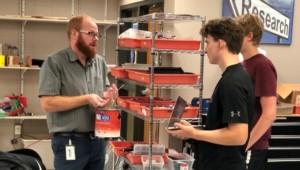Teaching Math Without Words—And Getting Big Gains
 Mathematical thinking is a problem-solving skill but we use a lot of abstract symbols and words to try to teach kids math procedures. Just look at a textbook or observe a middle school classroom. Our text-based approach works for some students but is confusing and complicated for too many, including those new to the language or with reading difficulties.
Mathematical thinking is a problem-solving skill but we use a lot of abstract symbols and words to try to teach kids math procedures. Just look at a textbook or observe a middle school classroom. Our text-based approach works for some students but is confusing and complicated for too many, including those new to the language or with reading difficulties.
“Spatial-temporal reasoning is the ability to visualize spatial patterns and mentally manipulate them over a time-ordered sequence of spatial transformations.” According to Wikipedia, “This ability is important for generating and conceptualizing solutions to multi-step problems that arise in areas such as architecture, engineering, science, mathematics, art, games, and everyday life.”
It turns out that spatial reasoning is not only a 21st Century skill but it’s a great way to teach math. Dr Matthew Peterson makes the case in this TEDx video that a visual approach to math is the best way to teach all students—visual learners, English learners, and struggling readers. Dr. Peterson spent the last decade developing a visual and game-based approach to teaching math. The nearly 900 games, called ST Math, teach math from kindergarten to Algebra 1 by first introducing each math concept as a visual puzzle without words.
The common objective of each game is to move Jiji the penguin across the screen. With no written instructions, ST Math relies on trial and error and student intuition. Students quickly pick up on the informative visual animations and benefit from instant feedback and hints.
The self-paced software is easy for schools to incorporate. MIND Research Institute, the nonprofit developer of ST Math, suggests just two 45 minute sessions each week to complement traditional math instruction. This simple addition has gap closing potential.
ST Math is used by more than 1200 schools nationwide. In randomized controlled trials, researchers from UC Irvine found an impressive effect size. In Orange County, they found that ST math tripled the level of math proficiency growth. Similar gap closing results have been replicated in Silicon Valley, Houston, Chicago, and Las Vegas.
It is clear that removing the language barriers boosts math proficiency. Dr Peterson says, “Increasing test scores is great, but we also want to increase real mathematical thinking.” The innovative games train students in multi-step problem-solving by encouraging students to connect the dots in their own heads about how math works. Dr Peterson is driven by the belief that, “All students can benefit profoundly from some opportunities to learn without words at all.”






0 Comments
Leave a Comment
Your email address will not be published. All fields are required.